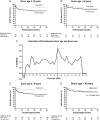Higher Risk of Posttransplant Liver Graft Failure in Male Recipients of Female Donor Grafts Might Not Be Due to Anastomotic Size Disparity
- PMID: 29443826
- PMCID: PMC7228631
- DOI: 10.1097/TP.0000000000002118
Higher Risk of Posttransplant Liver Graft Failure in Male Recipients of Female Donor Grafts Might Not Be Due to Anastomotic Size Disparity
Abstract
Background: Posttransplant liver graft failure occurs most often in male recipients of livers from female donors. The respective role of donor sex itself and the size disparity in graft vessels/bile ducts according to donor sex are unclear. Thus, we aimed to evaluate the importance of donor sex with adjustment for anastomotic size disparity between female and male donor grafts.
Methods: A total of 309 male patients without hepatic tumors who underwent living donor liver transplantation were analyzed (109 female donors and 200 male donors). The primary outcome was posttransplant graft failure (ie, retransplantation or death). Survival analysis was performed using the Cox model. Analyzed anastomosis-related factors comprised graft weight, number and size of hepatic vessels/bile ducts, and anastomosis techniques.
Results: Graft failure probabilities at 1, 6, 12, 24, and 60 months posttransplantation were 9.1%, 19.5%, 20.2%, 23.0%, and 27.0%, respectively, with female donors and 2.0%, 5.5%, 8.1%, 10.1%, and 13.5% with male donors (hazards ratio [HR], 2.29; 95% confidence interval [CI], 1.35-3.88; P = 0.002). Multivariable analysis confirmed the significance of donor sex (HR, 2.30; 95% CI, 1.14-4.67; P = 0.021) after adjustment for anastomosis-related factors. All analyzed anastomosis-related factors showed no significant association with graft failure, although size of the graft hepatic artery showed marginal significance (HR, 0.50; 95% CI, 0.25-1.01; P = 0.053). The significance of donor sex was lost when donor was older than 36 to 40 years (age of poor ovarian reserve and the end of female fertility). Our institutional pediatric recipient cohort validated the inferiority of female-to-male donation.
Conclusions: Donor sex appears to be an independent factor modulating graft failure risk in male liver transplant recipients.
Conflict of interest statement
The authors declare no funding or conflict of interest.
Figures




References
-
- Kahn D, Gavaler JS, Makowka L. Gender of donor influences outcome after orthotopic liver transplantation in adults. Dig Dis Sci. 1993;38:1485. - PubMed
-
- Brooks BK, Levy MF, Jennings LW. Influence of donor and recipient gender on the outcome of liver transplantation. Transplantation. 1996;62:1784. - PubMed
-
- Smith CM, Davies DB, McBride MA. Liver transplantation in the United States: a report from the Organ Procurement and Transplantation Network. Clin Transpl. 2000:19–30. - PubMed
-
- Rustgi VK, Marino G, Halpern MT. Role of gender and race mismatch and graft failure in patients undergoing liver transplantation. Liver Transpl. 2002;8:514. - PubMed
MeSH terms
LinkOut - more resources
Full Text Sources
Other Literature Sources
Medical

